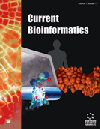- Home
- A-Z Publications
- Current Bioinformatics
- Previous Issues
- Volume 17, Issue 4, 2022
Current Bioinformatics - Volume 17, Issue 4, 2022
Volume 17, Issue 4, 2022
-
-
A Machine Learning Perspective on DNA and RNA G-quadruplexes
More LessAuthors: Fabiana Rossi and Alessandro PaiardiniG-quadruplexes (G4s) are particular structures found in guanine-rich DNA and RNA sequences that exhibit a wide diversity of three-dimensional conformations and exert key functions in the control of gene expression. G4s are able to interact with numerous small molecules and endogenous proteins, and their dysregulation can lead to a variety of disorders and diseases. Characterization and prediction of G4-forming sequenc Read More
-
-
-
Construction of Network Biomarkers Using Inter-Feature Correlation Coefficients (FeCO3) and their Application in Detecting High-Order Breast Cancer Biomarkers
More LessAuthors: Shenggeng Lin, Yuqi Lin, Kexin Wu, Yueying Wang, Zixuan Feng, Meiyu Duan, Shuai Liu, Yusi Fan, Lan Huang and Fengfeng ZhouAims: This study aims to formulate the inter-feature correlation as the engineered features. Background: Modern biotechnologies tend to generate a huge number of characteristics of a sample, while an OMIC dataset usually has a few dozens or hundreds of samples due to the high costs of generating the OMIC data. Therefore, many bio-OMIC studies assumed inter-feature independence and selected a feature with a high p Read More
-
-
-
A Network-Based Method for the Detection of Cancer Driver Genes in Transcriptional Regulatory Networks Using the Structural Analysis of Weighted Regulatory Interactions
More LessAuthors: Mostafa Akhavan-Safar, Babak Teimourpour and Abbas Nowzari-DaliniBackground: Identifying genes that instigate cell anomalies and cause cancer in humans is an important field in oncology research. Abnormalities in these genes are transferred to other genes in the cell, disrupting its normal functionality. Such genes are known as cancer driver genes (CDGs). Various methods have been proposed for predicting CDGs, mostly based on genomic data and computational methods. Some novel bioi Read More
-
-
-
A Combined Feature Screening Approach of Random Forest and Filterbased Methods for Ultra-high Dimensional Data
More LessAuthors: Lifeng Zhou and Hong WangBackground: Various feature (variable) screening approaches have been proposed in the past decade to mitigate the impact of ultra-high dimensionality in classification and regression problems, including filter based methods such as sure independence screening, and wrapper based methods such as random forest. However, the former type of methods rely heavily on strong modelling assumptions while the latter on Read More
-
-
-
Analyzing Association Between Expression Quantitative Trait and CNV for Breast Cancer Based on Gene Interaction Network Clustering and Group Sparse Learning
More LessAuthors: Xia Chen, Yexiong Lin, Qiang Qu, Bin Ning, Haowen Chen, Bo Liao and Xiong LiAim: The occurrence and development of tumor are accompanied by a change in pathogenic gene expression. Tumor cells avoid the damage of immune cells by regulating the expression of immune- related genes. Background: Tracing the causes of gene expression variation is helpful to understand tumor evolution and metastasis. Objective: Current explanation methods for gene expression variation are confronted with s Read More
-
-
-
A Novel Method for Predicting Essential Proteins by Integrating Multidimensional Biological Attribute Information and Topological Properties
More LessAuthors: Hanyu Lu, Chen Shang, Sai Zou, Lihong Cheng, Shikong Yang and Lei WangBackground: Essential proteins are indispensable to the maintenance of life activities and play essential roles in the areas of synthetic biology. Identification of essential proteins by computational methods has become a hot topic in recent years because of its efficiency. Objective: Identification of essential proteins is of important significance and practical use in the areas of synthetic biology, drug targets, and huma Read More
-
-
-
Analysis of Novel Variants Associated with Three Human Ovarian Cancer Cell Lines
More LessAuthors: Venugopala R. Mekala, Jan-Gowth Chang and Ka-Lok NgBackground: Identification of mutations is of great significance in cancer research, as it can contribute to the development of therapeutic strategies and prevention of cancer formation. Ovarian cancer is one of the leading cancer-related causes of death in Taiwan. Furthermore, it has been observed that the accumulation of genetic mutations can lead to cancer. Objective: We utilized whole-exome sequencing to explore can Read More
-
Volumes & issues
-
Volume 20 (2025)
-
Volume 19 (2024)
-
Volume 18 (2023)
-
Volume 17 (2022)
-
Volume 16 (2021)
-
Volume 15 (2020)
-
Volume 14 (2019)
-
Volume 13 (2018)
-
Volume 12 (2017)
-
Volume 11 (2016)
-
Volume 10 (2015)
-
Volume 9 (2014)
-
Volume 8 (2013)
-
Volume 7 (2012)
-
Volume 6 (2011)
-
Volume 5 (2010)
-
Volume 4 (2009)
-
Volume 3 (2008)
-
Volume 2 (2007)
-
Volume 1 (2006)
Most Read This Month
Article
content/journals/cbio
Journal
10
5
false
en


